The Sabu Disk, discovered in 1936 in the tomb of Prince Sabu at the Saqqara necropolis, remains one of ancient Egypt’s most enigmatic artifacts. Dating back to the First Dynasty (circa 3000-2800 BC), this curious stone object has captivated historians, archaeologists, and conspiracy theorists alike due to its mysterious design and unknown purpose. Crafted from fragile schist, the Sabu Disk’s unique form and the various theories surrounding its use have led to widespread speculation. This article delves into the disk’s history, craftsmanship, and the numerous hypotheses that attempt to explain its function, all while shedding light on gaps in current research that continue to fuel the intrigue.
History of the Sabu Disk
The Sabu Disk was unearthed during an excavation led by British Egyptologist Walter Bryan Emery in 1936. It was found within the mastaba tomb S3111, the final resting place of Prince Sabu, a high-ranking official during the First Dynasty. The tomb, located in the northern part of the Saqqara necropolis, contained various artifacts, but none as puzzling as the Sabu Disk.
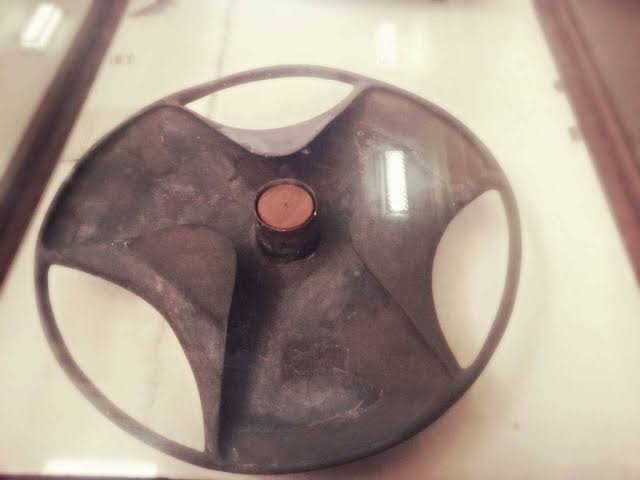
Prince Sabu’s tomb, which also held typical grave goods like pottery, stone vessels, and animal bones, was looted long before Emery’s discovery. However, the Sabu Disk was found in a central position within the burial chamber, suggesting it held significant importance.
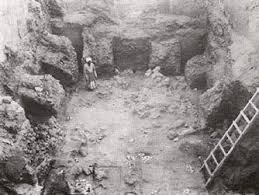
Physical Description
The Sabu Disk is a shallow, bowl-shaped artifact measuring 61 centimeters in diameter and 10.6 centimeters in height. It features a central hole approximately 8 centimeters in diameter, surrounded by three curved lobes that extend towards the center, giving it an appearance reminiscent of a modern steering wheel. Made from schist, a brittle and delicate stone, the disk’s construction would have required exceptional skill and precision, particularly given the intricate design and the fragile nature of the material. The disk’s smooth finish and symmetrical design further emphasize the advanced craftsmanship of the ancient Egyptians.
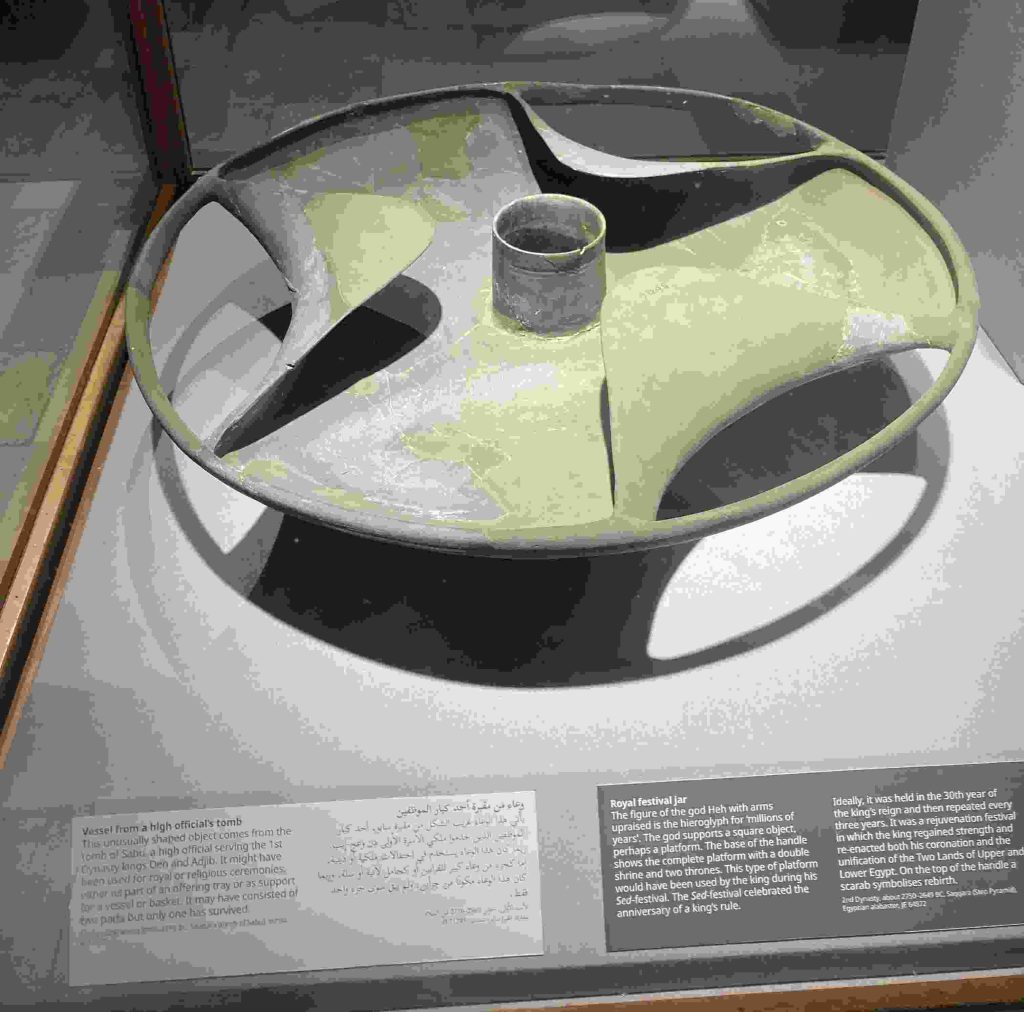
Theories on the Purpose
Since its discovery, the Sabu Disk’s purpose has been a topic of debate among scholars and enthusiasts alike. Walter Bryan Emery, the disk’s discoverer, initially suggested that it might have been a vessel used in conjunction with a stand, although no such stand was found in the tomb. Other early interpretations proposed that the disk might have served as a type of lamp or even as a component of ancient water management systems due to its design, which would allow it to function efficiently in a liquid medium.
Over the years, more speculative theories have emerged. Some suggest that the Sabu Disk was an imitation of a metal object, perhaps a component of a larger machine, such as a flywheel for energy storage. Others, influenced by fringe theories, believe the disk could have been part of an advanced technology brought to Egypt by extraterrestrial beings, citing its aerodynamic properties as evidence. Modern experiments with 3D-printed replicas of the disk have shown that it could theoretically function as a flying object, although its exact purpose remains speculative.
The Disk’s Unique Craftsmanship
The creation of the Sabu Disk from schist is an impressive feat, considering the material’s fragility. Schist, a metamorphic rock, is difficult to work with, especially when crafting objects with intricate designs. The disk’s thin, curved lobes and the central hub would have required not only advanced tools but also a high degree of skill to avoid breaking the stone during the carving process. The disk’s design, which lacks any direct parallels among other known Egyptian artifacts, further underscores its uniqueness.
When compared to other stone objects from the First Dynasty, the Sabu Disk stands out due to its unusual form. While other large stone bowls and vessels from this period are known, none match the disk’s complexity and delicate features. This suggests that the Sabu Disk was not a utilitarian object but perhaps had a symbolic or ceremonial function.
Experimental Analysis
In recent years, the Sabu Disk has been subjected to modern scientific analysis, including experiments with 3D-printed models. These replicas have demonstrated that the disk possesses certain aerodynamic properties, which could imply it was designed to rotate or fly. However, due to its non-chiral symmetry, it is unlikely to have served as a propeller or turbine, as some have suggested. Additionally, tests have indicated that the disk could function as a three-flame oil lamp, supporting earlier hypotheses about its use in ritualistic contexts.
Despite these analyses, the true purpose of the Sabu Disk remains elusive. The lack of definitive evidence has led some to propose that the disk might have been a symbolic object, possibly representing something significant within ancient Egyptian culture, such as the sun or a divine entity.
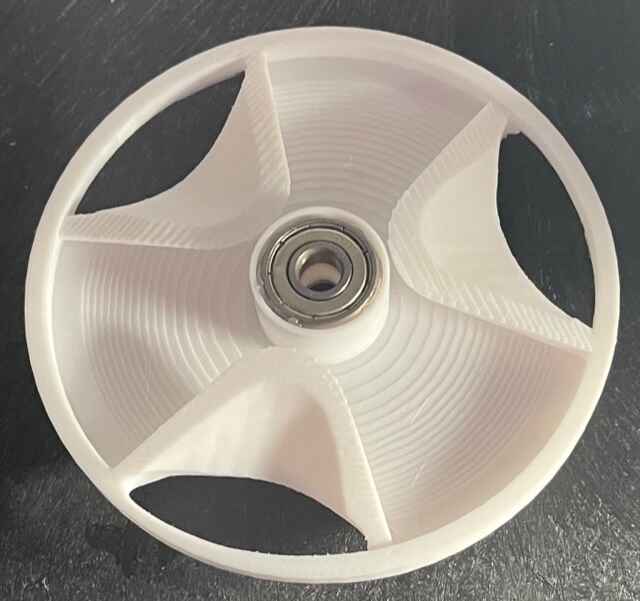
Cultural and Symbolic Interpretations
The Sabu Disk may hold cultural and symbolic significance that extends beyond its physical properties. In ancient Egyptian society, objects placed in tombs were often imbued with religious or symbolic meaning, intended to aid the deceased in the afterlife. The disk’s placement in a central position within Prince Sabu’s burial chamber suggests it was an important item, possibly linked to religious rituals or beliefs.
Some researchers have speculated that the disk could symbolize the sun or a celestial body, aligning with the ancient Egyptians’ deep reverence for the cosmos. Alternatively, the disk’s design, resembling a steering wheel, might have been intended to symbolize control or guidance, both of which were important concepts in Egyptian religious thought.
The Sabu Disk in Modern Media
The Sabu Disk has captured the public imagination, particularly in the realm of fringe theories and popular culture. It has been featured in numerous books, documentaries, and online discussions, often presented as evidence of advanced ancient technology or even extraterrestrial influence. Prominent figures like Erich von Däniken have popularized the idea that the disk might be an out-of-place artifact, hinting at lost civilizations or contact with alien beings.
Despite the sensationalism surrounding these theories, the Sabu Disk remains an important subject of study for serious Egyptologists and historians. Its presence in the Egyptian Museum in Cairo ensures that it continues to be a focus of scholarly attention, even as it fascinates the general public.
Comparison with Similar Artifacts
While the Sabu Disk is unique in its design, it can be compared to other stone objects from the same period to better understand its significance. Similar stone vessels, though less intricate, have been found in Saqqara and other ancient Egyptian sites, indicating that stone craftsmanship was highly developed during the First Dynasty. However, the Sabu Disk’s complex design sets it apart, possibly reflecting an understanding of advanced biological knowledge and suggesting that it may have had a special function or symbolic meaning not shared by other artifacts.
One notable comparison is with the tri-lobed disc found in the tomb of Hemaka, another high-ranking official from the First Dynasty. While the Hemaka disc is simpler in design, its existence suggests that the concept of lobed or multi-spoked objects was not entirely unique to the Sabu Disk. However, the Sabu Disk’s more elaborate form and the mystery surrounding its purpose continue to make it a subject of particular interest.
Technological Speculations
Theories about the Sabu Disk’s technological function often delve into speculative territory. Some propose that it was part of an ancient machine, possibly related to water management or energy storage, which could indicate a higher level of ancient Egyptian technology than previously understood. Others suggest that it could have been a component of a device used in religious or ceremonial practices, such as a ritualistic flywheel or a device to create hypnotic or meditative states.
One of the more intriguing technological theories is that the disk might have been used in brewing beer, functioning as a mash rake to stir and aerate the mixture of grains and water. This theory is supported by the disk’s design, which would allow it to function efficiently in a liquid medium. However, like many other hypotheses, this idea remains unproven due to the lack of direct evidence.
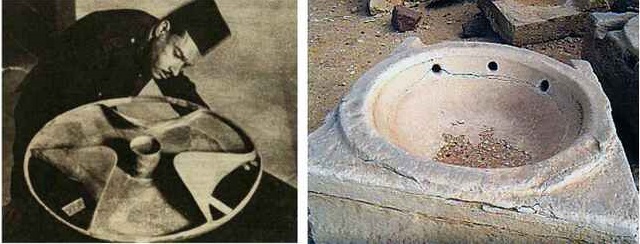
Gaps in Current Research
Despite the extensive research and speculation surrounding the Sabu Disk, many questions remain unanswered. Key gaps include the lack of definitive evidence regarding its function, the absence of similar objects that could provide comparative data, and the limited discussion of the disk in mainstream Egyptology. Further research, particularly involving more advanced scientific techniques, could help shed light on these mysteries.
Additionally, the cultural and symbolic aspects of the Sabu Disk have not been fully explored. Understanding the religious or ceremonial significance of the disk could provide important context for its purpose and use. As new technologies and methods become available, there is potential for future discoveries that could finally unlock the secrets of this enigmatic artifact.
Frequently Asked Questions (FAQs)
1. What was the Sabu Disk used for?
The exact purpose of the Sabu Disk remains unknown. Theories range from it being a ceremonial object to a component of an ancient machine or tool.
2. What is the Schist Disk?
The Schist Disk, commonly referred to as the Sabu Disk, is an ancient Egyptian artifact made from schist, a brittle and delicate stone. It was discovered in the tomb of Prince Sabu and dates back to the First Dynasty.
3. Is the Sabu Disk related to ancient technology?
Some theories suggest the Sabu Disk might be linked to advanced ancient technology, but there is no definitive evidence to support these claims.
4. Where is the Sabu Disk currently displayed?
The Sabu Disk is on display at the Egyptian Museum in Cairo, where it continues to intrigue visitors and researchers alike.
5. Why is the Sabu Disk considered mysterious?
The Sabu Disk is considered mysterious due to its unique design, the material used, and the lack of consensus on its purpose, leading to various theories and speculations.
6. How was the Sabu Disk made?
The Sabu Disk was intricately carved from a single piece of schist, a challenging material to work with due to its brittleness. The craftsmanship required to create such a delicate and complex object would have been considerable.
7. What are some theories about the Sabu Disk’s purpose?
Theories about the Sabu Disk’s purpose include it being a ceremonial object, a flywheel, a part of an ancient machine, or a symbolic representation of religious or cultural beliefs.
Conclusion
The Sabu Disk remains one of ancient Egypt’s most fascinating and mysterious artifacts. Despite decades of study, its purpose and significance continue to elude researchers, fueling ongoing debates and speculation. Whether a ceremonial object, a technological tool, or something entirely different, the Sabu Disk is a testament to the skill and creativity of ancient Egyptian artisans. As research progresses, there is hope that the true nature of this enigmatic disk will one day be revealed, unlocking new insights into one of history’s oldest civilizations.
Use of Our Content
⚠️ Content on “Mystery Uncover” is protected under US and International Copyright Laws.
You are free to reuse, republish, and share our content by giving credit to the source as Mystery Uncover with a link to the original material on mysteryuncover.com.






